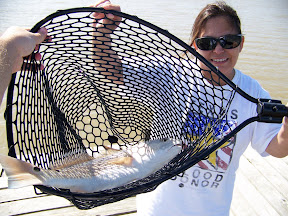Bayorhythms

The tidal ebb and flow can be predicted by the movement of the moon, and the wind tends to rise and fall with the sun. The changing seasons influence the movement of bait, which in turn influences the fish that prey upon them. These are the obvious factors. The not so obvious rhythms are often over-shadowed by the predominant factors of the day, and are easily missed by the fair-weather fisherman.
The movement of seasonal weather fronts can often reverse or double the effect of the tides, especially in back-water bays where narrow cuts restrict the movement of water into and out of the system. This effect might last for days if, for example, a strong Northern front combines with an out-going tide to quickly drain the water out of the bay. The North wind continues past the onset of the next in-coming tide, which blocks the water from returning. The strong Norther includes some hard rain, the runoff of which refills the bay with fresh water, significantly lowering the salinity level. The muddy runoff water in the shallow bay warms quickly under the clear blue sky following the front, raising the water temperature by several degrees. In only two days, the entire system is turned upside down and might take weeks to recover. The weekend fisherman who failed to look at the previous weeks weather report might waste an entire day wondering why the fish weren't biting at his favorite fishing hole, when the day's weather was absolutely perfect!
It pays to look at the larger patterns over the course of several days, with an eye toward seeing the big picture. The fishing magazines are good at doling out 'rules of thumb', but I find that these are only mildly useful at best. The only real way to understand the unique characteristics of any bay system is to get out on the water and observe. This means take the time to notice how things change between visits, actually taste the water, and think about what might be causing the change. As you accumulate experience, you will begin to make mental connections - sometimes subconsciously. As you get in tune with the natural rhythm of things, subtle events begin to stand out against the background music. In other words, you begin to notice things. You begin to see the fish in the water.
You don't actually see them in a literal way, but you notice their effect on the surrounding environment. Like how a slight v-shaped bulge that interrupts the breeze pattern on the waters surface draws your eyes expecting to see a fish. The small bait jumping ahead of the swell tells your brain that it is a fish, and probably predatory. The proximity of the swell to a nearby grass bed tells your brain that its a redfish. Your hope and desire tells your brain that it is a big redfish, and you may exclaim to yourself or to your friend, "Look at the size of that redfish!", although you may not have actually, really seen it. If you have experienced this before, and have had the inclination to try to catch it, and maybe you cast a spoon ahead of the bulge in the water and actually did catch one, you would probably be right on the money this time. You might be inclined to try it again. This is what makes a good fisherman.
I think this theme can be expanded to life in general. Go with the flow, get out and experience life and get in tune with the natural rhythms that are taking place around you. This works as well in traffic as it does in the office, and even in your personal life. Affect desired change by applying subtle influence over time. This allows others to adapt more gracefully to the changes you are trying to make. Its like when you are backing your trailer down the boat ramp. If you stop and start, and make drastic changes to your direction, you will never make it to the bottom of the ramp. If, on the other hand you proceed carefully and make continuous small adjustments to your direction, you will most likely find success.




















